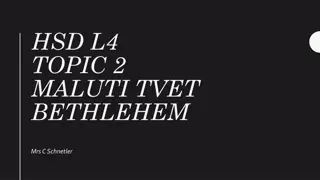Financial Intelligence Webinar Series: Managing Financial Risks
Explore the intricacies of financial decision-making across different timeframes, from short- to long-term, in the Financial Intelligence webinar series. Gain insights on optimizing profits, managing revenue, margins, and overheads, and conducting a comprehensive financial health check to ensure financial stability and growth.
Download Presentation

Please find below an Image/Link to download the presentation.
The content on the website is provided AS IS for your information and personal use only. It may not be sold, licensed, or shared on other websites without obtaining consent from the author.If you encounter any issues during the download, it is possible that the publisher has removed the file from their server.
You are allowed to download the files provided on this website for personal or commercial use, subject to the condition that they are used lawfully. All files are the property of their respective owners.
The content on the website is provided AS IS for your information and personal use only. It may not be sold, licensed, or shared on other websites without obtaining consent from the author.
E N D
Presentation Transcript
Program overview Financial Intelligence webinar series 5. Managing financial risks 2. Longer term financial decisions 3. Medium term financial decisions 4. Short term financial decisions 1. Financial basics
Learning outcomes Profit is better than margins for decisions that span seasons Sheep farming decisions can span several cropping seasons Profit is increased by managing revenue, margins and overheads
Financial health check Strong range Ratio Formula Result Weak range Liquidity 1.Current ratio 2.Working capital Efficiency 3.Input cost ratio Revenue to asset ratio Profitability 5.Operating profit ratio (E / A)* 100 6.Net profit ratio 7.Plant to gross income (U / A) : 1 8.Return on assets 9.Return on equity Debt 10.Equity to assets 11.Interest cover ratio S / W S - W 1.1 <1.1 times Negative >1.5 times ? Positive ? $ 10,000 (B / A)* 100 37.5% > 40% < 25% ? 4. (A / V)* 100 22.9% < 15% > 30% 27.5% 18.0% 0.7:1 4.1% 5.5% < 15% < 20% >1:1 < 2.5% < 2.5% > 30% > 30% <0.8 ? > 5.0% > 5.0% (G / A)* 100 (G / V)* 100 (G / Z)* 100 (Z / V) * 100 (E / F)* 100 76% 2.89 < 70% < 1 times > 90% ? > 2 times
Start by allocating indirect expenses to enterprises $ allocated Sheep Crops Total ($'000) % allocated to sheep Overhead $100 50% $50 $50 Management labour $80 20% $16 $64 Depreciation $60 15% $9 $51 Fuel/oil $50 15% $8 $43 Plant repairs $15 100% $15 $0 Water and fences $15 30% $5 $11 Insurance Admin, rates, accountant etc $40 50% $20 $20 Total overheads ($'000) $360 $122 $238
Next work out your profit on enterprise production Sheep DP SR Cropping Comments 2000ha total excludes non-arable Area (arable hectares (ha)) 1000 1000 Direct costs $ 200 000 $ 325 000 All direct enterprise costs 1 Indirect costs $ 122 000 $ 238 000 As per previous slide 2 Land cost allocation $ 150 000 $ 150 000 Commercial lease rate 3 Total cost of production (COP) $ 472 000 $ 713 000 1 + 2 + 3 4 Total COP $/ha $ 472 $ 713 4 / arable ha Production (kg lamb or t grain) 90 000 2 800 3 year average 5 COP ($/kg cwt or $/t) $ 5.24 $ 255 4 / 5 6 Price $/kg cwt or $/t $ 4.50 $ 280 3 year average 7 Value of production (lamb or grain) $ 405 000 $ 784 000 5 x 7 8 Profit/loss on lamb production -$ 67 000 $ 71 000 8 - 4 9 ADD wool production (kg) 25 000 3 year average 10 Break even wool price to cover loss Wool price $/kg greasy Profit/loss on enterprise production $ 2.68 $ 10 -9 / 10 (kg / GWt) 3 year average 11 $ 183 000 $ 71 000 production not sales
Profit calculations using COP Total $ 250 000 $ 351 000 -$ 472 000 -$ 50 000 $ 150 000 $ 229 000 $ 784 000 -$ 713 000 $ 150 000 $ 221 000 $ 450 000 $/ha $ 250 $ 351 -$ 472 -$ 50 $ 150 $ 229 $ 784 -$ 713 $ 150 $ 221 $ 225 Comments Wool sales Sheep sales Less: COP sheep Less: Flock decrease Add back: Land cost EBIT Sheep Crop sales Less: COP grain Add back: Land cost EBIT Cropping Total EBIT Wool price x wool production (above) All classes sold not lambs produced From previous slide (row 4) Assume COP for flock reduction This is an opportunity cost not $ From above (if sales = production) From previous slide (row 4) This is an opportunity cost not $ Add sheep and cropping EBIT Interest and any land lease payments Less Finance -$ 200 000 -$ 100 NPBT Less Tax NPAT $ 250 000 $ 75 000 $ 175 000 $ 125 $ 37.50 $ 87.50 Using a 30% rate
Enterprise mix and sheep Future Productivity Diversify income Weed control Soil health
Profit drivers Farm Sheep Gross margin optimisation Price x Production Costs = Profit Risk management Maximise price (e.g. timing) People and management Maximise production (aka yield) Develop low cost business model Optimise costs (esp. labour)
Improving profitability Step 1: Increase revenue Assume we want to increase revenue by 6%, reduce variable costs by 1% (of revenue) and lower overheads by 5%. The following table shows the impact. Step 2: Reduce variable costs Now Change Target Sales $ 1000 6.0% $ 1060 Variable costs 60% -1.0% 59% Gross profit $ 400 $ 435 Overheads $ 300 -5.0% $ 285 Step 3: Lower overheads Net profit $ 100 $ 150
What can you do? ? To increase revenue by 6%? ? To save 5% on overheads? To reduce variable costs by 1% of revenue? ?
To increase sheep revenue Stocking rate (DSE / wgha) Know potential and what you've lost Wool yield and quality Lamb yield & efficiency Prices Average sale weight (lw) Scanning rate Av wool cut/ewe Av wool price Average sale weight (cwt) Average sale price $/kg lw or cwt Marking rate Av wool cut/wether Average age at sale (days) Average sale value $/head Weaning rate Wool cut/wgha Lambs produced/wgha Losses Av micron Lambs sold/wgha Key: average (Av) dry sheep equivalent (DSE) winter grazed hectares (wgha) live weight (lw) carcase weight (cwt) grams per head per day (g/hd/day) Growth rate to sale date g/hd/day
Saving 5% in overheads Permanent wages Set productivity targets Work cover Insurance Repairs and maintenance Keep to schedule Sound OHS procedures Review providers and amounts Utilities Monitor for waste / leaks Subscriptions Libraries and online options Communication Usage and plans Training Free seminars, webinar options Professional fees Good organisation and presentation of record Fuel and oil Regular maintenance
Consider technology Electrodip automated jetting race Remote cameras Individual health applicator Pedigree matchmaker Electronic identification Sheep handler Identification and recording software New sheep yards Wifi networks Sensors to determine maternal pedigree Livestock recording apps
Control machinery costs by Hire contractors Buy second hand machinery Share machinery with other grain growers (syndicate ownership) Lease more land using the same machinery to lower the per hectare cost Hire additional labour to use machinery for more hours in day (e.g. at seeding work around the clock) Improve logistics efficiency (e.g. use of chaser bins, trucking contractors) Provide contract services to other growers to increase earnings from the machinery
What will you now start, stop, continue doing? Use profit rather than margins for decisions that span seasons Understand that sheep farming decisions can span several cropping seasons Identify strategies for increasing profit by managing revenue, margins and overheads
Webinar wrap up Summary Questions Homework
References and further reading agric.wa.gov.au/generating-more-profit- your-farm-business?page=0%2C3 Generating more profit form your farm file:///C:/Users/Doug/Downloads/Dolling+Per ry+Fodder+crops+provide+benefits+for+she ep+and+crop.pdf Fodder crops provide benefits for sheep and crop New on farm technology for sheep producers agric.wa.gov.au/feeding-nutrition/new-farm- technology-sheep-producers Tools, training and information specifically aligned to sheep farming mla.com.au/extension-training-and- tools/making-more-from-sheep/ mla.com.au/extension-training-and- tools/tools-calculators/ Cost of production calculators gc- supplement.realviewdigital.com/?iid=157256 #folio=1 Profit drivers























